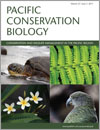
Pacific Conservation Biology
Volume 23 Number 2 2017
PC16035Ecologists, economics and politics: problems and contradictions in applying neoliberal ideology to nature conservation in Australia
Neoliberal ideology centres on the transfer of State responsibility over the provision of public goods, including the environment, to the global free-market market under the dual premises of increased allocation efficiency and maximised individual utility. Approaches to wetland conservation and management in Australia have, over the past three decades, been increasingly dominated by the neoliberal value system. In this paper we examine the limitations of two pillars of neoliberal orthodoxy – (1) monetary valuation of biodiversity and ecosystem services, and (2) the provision of complementary areas to offset losses of high-quality habitat – to the management and conservation of wetlands in south-eastern Australia.
PC16034The multiple faces of sustainability – from sustained yield to sustainable development
Sustained yield is the amount or number of a resource that can be harvested without decline. Sustainable development is development that meets the needs of human society without compromising future generations’ ability to meet their needs. This paper: (1) describes sustained yield and sustainable development, and (2) draws some conclusions about the two concepts, including their relationship, or lack thereof.
PC16031Culture, kastom and conservation in Melanesia: what happens when worldviews collide?
This essay features lessons from attempts across Melanesia at establishing protected areas, conservation agreements, ecotourism initiatives and research-action arenas that showcase challenges and conflicts when worldviews collide and opportunities that arise for improving conservation effectiveness when mutual expectations are clarified early on during planning processes.
PC16024Is the Biodiversity Conservation Act 2016 (WA) fit for purpose?
We summarise the major flaws retained in the Biodiversity Conservation Act 2016 as it progressed from Bill to Act. We also suggest requirements of future legislation and discuss the importance of effective conservation legislation in the 21st century.
PC16032Distribution and diversity of Phytophthora across Australia
Using high-throughput sequencing, 68 Phytophthora species were detected from eDNA extracted from 640 soils samples collected from native ecosystems around Australia. Many of the species detected have a global distribution, but 30% were identified as potentially new taxa. Australian databases are biased toward Phytophthora species common in agriculture, and the additional records provided valuable baseline for future studies.
PC16036Histological analysis of hatchlings of the Australian lungfish, Neoceratodus forsteri, from water impoundments reveals fundamental flaws in development
Anomalies in young of the Australian lungfish are now found in altered environments but not in fish collected from natural rivers. The cause of abnormal development is the production of deficient eggs by adult lungfish that are not well fed. This has serious implications for survival of the species, since most lungfish habitats are now altered.
PC16037Diet patterns of island foxes on San Nicolas Island relative to feral cat removal
The effect of feral cats on diet patterns of island foxes on San Nicolas Island was examined during 2006–12. Although selection of food items by foxes appeared to shift when cats were removed, changes in diet patterns probably were more influenced by variation in prey availability associated with annual precipitation.
PC16030Where to survey? Spatial biodiversity survey gap analysis: a multicriteria approach
We combined spatial data into a multicriteria model to conduct a biological survey gap analysis for the public forest estate in south-west Western Australia. The model showed that the south-western parts of the study area were relatively well surveyed while eastern parts were relatively poorly surveyed, probably due to habitat loss where the forest adjoins the extensively cleared Western Australian wheatbelt.
PC17002Predators and genetic fitness: key threatening factors for the conservation of a bettong species
We developed a population viability model for the woylie (Bettongia penicillata ogilbyi), which identified predation by introduced animals and its interaction with reduced fitness (for example due to inbreeding depression or a disease) as main threatening processes. We anticipated that the developed framework will facilitate similar work in other bettong species.



